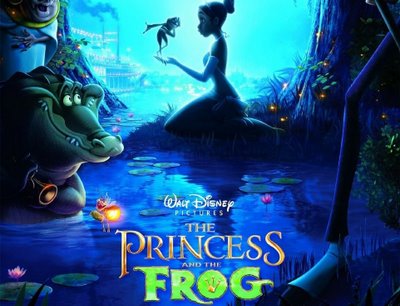Disney has come a long way with film technology since its humble originals. Now the company steps backward with old animation styles and steps forward with its first African American princess in “The Princess and the Frog.” Disney knows where the happiest place on earth is, and in the words of one of the film’s catchier tunes, it’s “Gonna Take You There.”
From the first musical number, you can tell “this is gonna be good.” In bustling New Orleans, Tiana waitresses to save money for her own dream restaurant. She thinks only of hard work and doesn’t believe in fairy tales, but that all changes when, dressed as a princess for a costume party, she meets a visiting prince looking for a princess to kiss. Only one problem: the prince’s froggy exterior is no costume.
Tiana kisses the frog, but instead of finding a handsome prince in front of her, she discovers the voodoo magic of the Shadow Man has turned her into a frog, too. Hardworking Tiana must put up with lazy Prince Naveen as they try to flee the Shadow Man and find a way to turn back into their true selves. Along the way, they run into a trumpet-playing crocodile, a firefly in love with the evening star and a voodoo queen who help them to understand that their true selves are more than just human bodies.
Sticking to regular Disney fashion, “The Princess and the Frog” recalls previous Disney films (and other films like “Shrek”) as it maintains a typical “be true to yourself” message on top of a love-over-money theme.
While these enduring themes will continue to woo audiences, the film still lacks in some areas. Too bad some cinematic royal didn’t kiss this frog of a film and turn it into the amazing film it had the potential to be.
The film gives Disney its first African American princess (not long after America elected its first African American president), but it hasn’t completely strayed from stereotypes like a rich white woman, a Cajun firefly and three hillbillies. But hey, it’s Disney, and where would the comedy come from without such characters? (Maybe Disney kept them for the same reason it left out the many negative historical circumstances of the 1920s.)
The supporting characters, however, never fully develop. Aside from Tiana and Naveen, who make a convincing and lovable couple, only rich girl Charlotte’s antics and the firefly’s romance are memorable. Louis the crocodile and Mama Odie the voodoo queen seem like quick thoughts thrown in to make the film longer. The film goes by too fast, and its climax and resolution, while enjoyable, would have enhanced the movie more had the filmmakers drawn them out just a bit longer.
One of the movie’s main character’s, the Shadow Man, hardly gets enough screen time. And while animators made his character entirely satisfying, his voice does not live up to standards set by past Disney villains. His “friends from the other side,” however, are more than spooky. They evoke the demonic atmosphere needed (maybe too much for younger viewers). Some of the best moments come from the shadows.
Some viewers may find this demonic atmosphere a bit too demonic, however, not because of how dark it is, but because it is dark. Voodoo plays a key role in the film, both a positive and negative role. While the Shadow Man gets what he deserves from his dealings with the devil, Mama Odie’s use of magic, while not portrayed as demonic, earns her the name of Voodoo Queen. This is Disney, and some viewers may assume innocence, but others will have a hard time recommending the film no matter how pleasant its lessons, characters and animation are.
For those who can get past the voodoo elements as negatives, the real delight comes in Disney’s return to 2D animation. After flops like “Home on the Range” and several films that went directly to video, one can understand why Disney took a break from putting it’s classic animation style on the big screen. Now, Disney makes a big comeback. While “The Princess and the Frog” cannot boast as colorful and breathtaking a picture as its commercials make it out to be, viewers will find this film a refreshing change from other animated films.
The film’s talented singers (Anika Nani Rose of Dreamgirls plays Tiana) and Broadway-style musical numbers also refresh viewers, but the music leaves them wanting more. Randy Newman’s score fits New Orleans perfectly, but one or two songs could use more jazzing up. Several of the Broadway-style numbers fail to completely satisfy. While they are fun, foot-tapping material, they don’t last long enough, and a few of them could use more engaging singers.
Despite its setbacks, “The Princess and the Frog” makes a great addition to the Disney royal lineup. With the help of directors John Musker and Ron Clements, who brought “Aladdin” and “The Little Mermaid” to life, Disney puts a unique twist on another classic fairy tale. Viewers will be “going down the bayou” for years to come.







